Assuming a downward-sloping demand curve for the firm, P = MR under ______, while P > MR under ______.
- perfect price discrimination; single pricing
- single pricing; perfect price discrimination
- single pricing; single pricing
- perfect price discrimination; perfect price discrimination
P = MR under perfect price discrimination because
- marginal revenue is by definition equal to price regardless of pricing strategy.
- selling one more unit always brings in revenue equal to the price regardless of pricing strategy.
- each unit is sold at the same uniform price.
- each unit is sold at a different highest possible price that could be afforded by the marginal buyer.
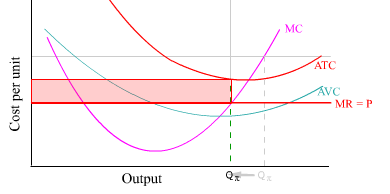
It makes sense for the price taker to stay in business in the short run even though P < ATC because
- there is no fixed cost in the short run.
- the firm only needs to pay for variable costs.
- price may be high enough to cover all the variable costs and part of the fixed cost.
- Both A and B.
A perfect price discriminator
- sells to each customer at his/her reservation price.
- has many competitors.
- sells at a single profit-maximizing price.
- sells commodities.

Consumer surplus is the difference between
- TWP and TR.
- TR and TFC.
- TR and TC.
- TWP and TC.

Comparing MR and MC alone do not tell us whether the price-taking firm is making or losing money in the short run because
- MC does not take into account variable cost.
- MR = MC maximizes efficiency not profit.
- Only the P and ATC can tell us whether the firm is making or losing money where MR = MC.
- All of the above.
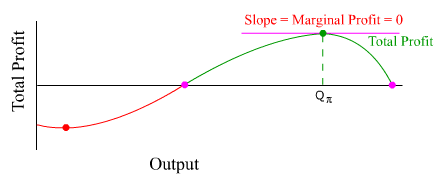
Marginal profit is ______ when profit is maximized under price taking.
- zero
- positive
- negative
- None of the above.
When demand is inelastic,
- a given percentage change in price would lead to an equal percentage change in quantity demanded.
- total revenue would go down as price falls.
- a 10% decrease in price would lead to 10% increase in quantity demanded.
- All of the above.
Issuing rebate coupons rather than an across-the-board price discount is a cheaper way to promote a product because
- most consumers would redeem their coupons.
- coupons cost nothing to print and distribute.
- more buyers are likely to redeem coupons than taking advantage of a straight price discount.
- those who do not redeem their coupons do not get the price discount.
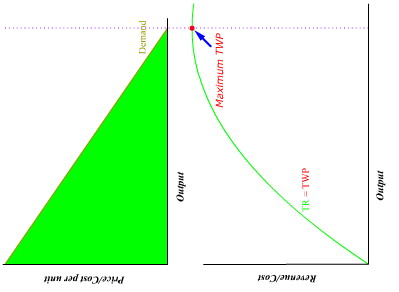
The total revenue curve of the perfect price-discriminating firm (TRdp) reaches a maximum when price reaches zero because
- only buyers who want the goods the most will buy at zero price.
- every sale adds to the total revenue if each unit is sold at the highest possible price the buyer is willing to pay.
- selling every unit at zero price guarantees that all units will be sold.
- demand is very elastic when price is zero.
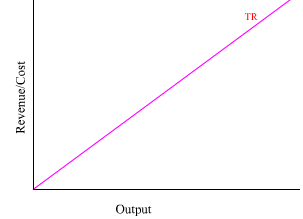
The constant positive slope of TR for price takers shows
- that each additional unit sold brings in higher prices.
- that there is a limit on how many units a price taker can sell.
- that price takers have some effect on the market price.
- the constant price determined by the market.
To prevent resale of concert tickets, the concert producer could
- Give away all the tickets for free.
- Perfectly price-discriminate.
- Charge the same price to everybody.
- Print ticket holder's name on the ticket and make them non-transferable.

Economic surplus is the difference between
- TR and TFC.
- TWP and TC.
- TR and TC.
- TWP and TR.
Cartels collapse easily because
- defectors are worse off than conformers.
- anti-trust authority condones cartels for price stability.
- defectors can gain a short-term advantage over conformers.
- anti-trust authority punishes defectors more harshly.
- conformers are better off than defectors.
Single pricing is practiced by
- price takers only.
- price discriminators.
- price takers and price searchers.
- Both A and B.
The value of a product to consumers is measured by
- the single price that they are charged by the single-price seller.
- their individual reservation prices.
- the single price that they are charged by price takers.
- the marginal revenue received by the single-price seller.
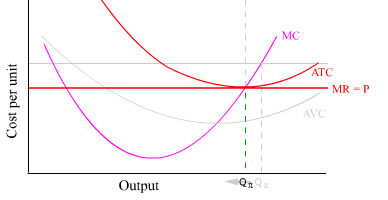
At equilibrium, price-taking firms in an industry with free market entry and exit will earn
- zero economic profit.
- positive economic profit.
- negative economic profit.
- None of the above.
Scalpers
- exists for the sole purpose of helping event promoters to sell out slow events.
- help event promoters to sell out tickets that are priced too high.
- skimp off consumer surplus reselling tickets by buying low and selling high.
- can return unsold tickets to event promoters.
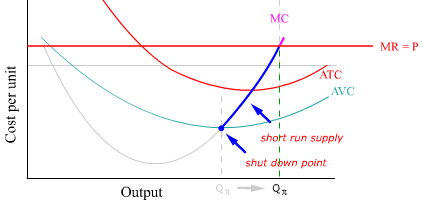
The shut-down point for a price taker in the short run is the point where the supply curve meets
- ATC at its minimum because P must cover ATC in the short run.
- AVC at its minimum because P only has to cover AVC in the short run.
- AFC at its minimum.
- MC at its minimum because rising MC will erode profit.
A price elasticity of demand at 0.5 means that a
- 100% decrease in price leads to a 50% decrease in quantity demanded.
- 5% increase in price leads to a 10% decrease in quantity demanded.
- 10% decrease in price leads to a 0.5% increase in quantity demanded.
- 10% decrease in price leads to a 5% increase in quantity demanded.